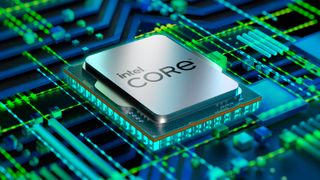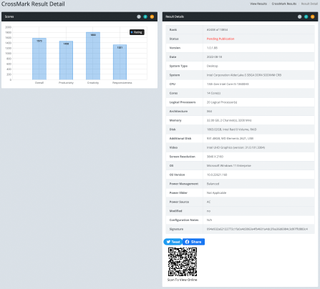Intel's Core i5-13600HX Raptor Lake Mobile CPU Benchmarked: Faster Than Alder Lake
But there is a catch.

While Intel plans to pull in release dates of its 13th Generation Core 'Raptor Lake' processors for notebooks, and many of these CPUs are set to be released later this year, until today, no benchmark results of those chips have leaked. Yet as Intel's partners begin to test new processors, some of their findings inevitably hit the Web.
Today someone accidentally (or purportedly) published benchmark results of Intel's Core i5-13600HX processor in BAPCo's CrossMark benchmark (via @momomo_us). The CPU has 14 cores and can process 20 threads simultaneously, which means either a 6P + 8E configuration or a 4P and 10E cores configuration (we assume the latter). To add some context, Intel's Core i5-12600HX processor has 12 cores (4P + 8E cores).
The CPU was tested using Intel's AlderLake-S SBGA DDR4 SODIMM CRB (customer reference board) equipped with 32GB of DDR4-3200 memory and two 1TB SSDs running in RAID mode as well as plugged into a 4K display.
| Header Cell - Column 0 | Overall | Productivity | Creativity | Responsiveness | Notes |
|---|---|---|---|---|---|
| Core i5-13600HX | 1573 | 1458 | 1800 | 1321 | 14C/20T; 32GB DDR4-3200 RAM |
| Core i5-12600H | 1350 | 1268 | 1747 | 752 | 12C/16T; 16GB DDR5-4800 |
| Core i5-12600H | 1760 | 1622 | 2013 | 1506 | 12C/16T; 32GB DDR5-4800 |
It is necessary to note that Intel's HX processors are aimed at desktop replacement laptops, and small form-factor desktops with good cooling as these CPUs feature base power of 55W and maximum turbo power of 157W. Since Intel's HX CPUs are not particularly popular among users of the general-purpose CrossMark benchmark, we had to compare the results of Intel's Core i5-13600HX (with a balanced power profile) with the Core i5-12600H. Meanwhile, the hitch is that all latter results were obtained on a system equipped with a Full-HD monitor, so the comparison is not fair. Nevertheless, we took the best (which used the best performance power profile) and the worst results of the model i5-12600H to give some additional perspective.
Another thing to point out is that BAPCo's CrossMark benchmark has three groups of tests (consisting of seven sub-scenarios) — Productivity (document editing, spreadsheets, web browsing), Creativity (photo editing, photo organization, video editing), and Responsiveness (application launches and the file opens taken from other sub scenarios) — designed to illustrate general system performance and responsiveness 'using models of real-world applications.'
All these scenarios are very general, so while they can quantify the difference between an entry-level Core i3-powered machine and a high-end Core i9-based system, we doubt that BAPCO's CrossMark can accurately illustrate the difference between Intel's Alder Lake and Raptor Lake.

Stay On the Cutting Edge: Get the Tom's Hardware Newsletter
Get Tom's Hardware's best news and in-depth reviews, straight to your inbox.

Anton Shilov is a Freelance News Writer at Tom’s Hardware US. Over the past couple of decades, he has covered everything from CPUs and GPUs to supercomputers and from modern process technologies and latest fab tools to high-tech industry trends.
-
cyrusfox ReplyThe CPU has 14 cores and can process 20 threads simultaneously, which means either a 6P + 8E cores configuration or a 4P and 10E cores configuration (we would assume the latter)
Why would you assume the latter? Have you ever seen E cores in groups other than 4??? it has to be 6P + 8 E.
Results look comparable to current gen. -
spongiemaster Reply
Because they can't do math. 4P and 10E cores would be 18 threads, not 20. If it was 4P cores, it would need to be 12E cores.cyrusfox said:Why would you assume the latter? Have you ever seen E cores in groups other than 4??? it has to be 6P + 8 E. -
TMRichard Additionally to Cyrusfox's point, someone failed maths class. Lets go over it slowly for those in the back:Reply
4 P-Cores with HTT are 8.... 10 E-Cores with no HTT are 10 = Total of 14 Cores and 18 threads - Can't be this one, the numbers don't match
6 P-Cores with HTT are 12.... 8 E-Cores with no HTT are 8 = Total of 14 Cores and 20 threads - HAS to be this one since both the number of threads and cores match up... either that or somehow 2 P or E cores get a magic 3rd/2nd thread which is just not happening -
JWMiddleeton Replycyrusfox said:Have you ever seen E cores in groups other than 4???
I recently bought an HP Pavilion laptop with an i7-1260p. It has 4P+8E cores. So, 4P core processors do exist.
CPU SpecificationsTotal Cores 12.
# of Performance-cores 4.
# of Efficient-cores 8.
Total Threads 16.
Max Turbo Frequency 4.70 GHz.
Performance-core Max Turbo Frequency 4.70 GHz.
Efficient-core Max Turbo Frequency 3.40 GHz.
Cache 18 MB Intel® Smart Cache. -
cyrusfox Reply
The point I was making is the E cores are in a cluster of 4 on the die. We have not seen Intel segment them in units less than 4(Curious if this is possible but as they share cache not sure), I think we will see 4,8,12,16 E cores with Raptor lake which from my understanding increased the cache as well as added another set of 2 E core clusters compared to Alder LakeJWMiddleeton said:I recently bought an HP Pavilion laptop with an i7-1260p. It has 4P+8E cores. So, 4P core processors do exist.
I have a 12900K and picked up a 12600K 2nd hand for cheap, I may upgrade both platforms next year. It is lame I need to use Process Lasso to get the E-Cores to behave and be useful in WIndows 10 though. I am going to skip Windows 11.
Most Popular



